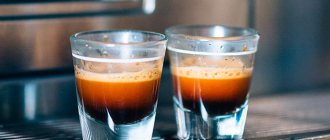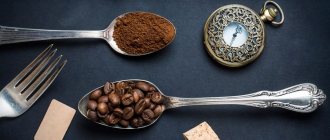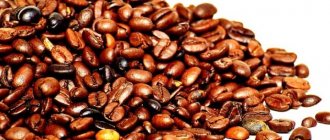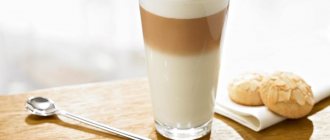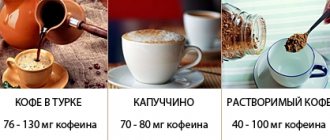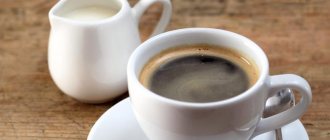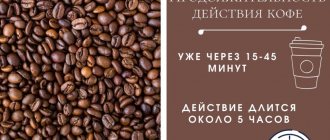In the 40s of the last century, the invention of the Swiss Max Morgenthaler - instant coffee - became famous. Since then, only true connoisseurs of the drink drink its grain version, while most people prefer simple and quick-to-prepare instant coffee. Of course, in terms of taste it can hardly be compared with that made from ground whole grains. In pursuit of saving time, you have to sacrifice something, but it’s still worth studying the calorie content of an instant drink. This will not only protect your figure from extra centimeters, but also drink instant coffee without harm to your health.
Calorie content of instant coffee
Coffee lovers are increasingly concerned about the caloric content of this drink.
Usually, the manufacturer honestly indicates the energy value of the product on the packaging, based on the weight of 100 grams. If we are talking about instant coffee, then its calorie content is usually in the range of 90-100 kcal per 100 grams of dry powder.
The figure, of course, is less than that of a natural grain drink containing many oils, but still noticeable. But for a cup of coffee, 1-2 teaspoons of powder or granules are usually used, which is approximately 10 grams. Using simple calculations, you can understand that the calorie content of an aqueous solution of coffee is 9-10 kcal.
Often the instant drink contains flavorings such as caramel, hazelnut or chocolate. A seemingly harmless chemical for your figure doubles the calorie content of black coffee!
Is the caloric content of freeze-dried, granulated and powdered coffee different?
Granulated coffee has the highest calorie content, followed by freeze-dried coffee, and powdered drink has the lowest calorie content
. It is no secret that instant coffee comes in three types, each of which has its own production characteristics. But does the technological process affect the calorie content of the drink? The most popular form of instant coffee is freeze-dried. Its calorie content varies from 90 to 140 kcal per 100 grams among different manufacturers, which means that a cup of such a drink has an energy value of 9-14 kcal, which is about 0.7% of the daily calorie intake.
Granulated coffee is slightly higher in calories and can reach 38 kcal per serving, this is due to the preservation of most essential oils during production. Powdered coffee contains only 5-8 kcal per cup, so such a drink will definitely not harm your figure, of course, if you do not abuse additives.
It turns out that the difference between types of instant coffee is insignificant, which means that the consumer’s choice depends only on taste preferences.
How did Nescafe come about?
Today, many brands produce coffee products. Nescafe is one of the most famous and affordable brands from Nestlé. She was the first to produce instant coffee.
The Nescafe brand is popular not only in Russia, but throughout the world. About eighty million cups of this aromatic drink are drunk every day around the world. Excellent taste and high quality products have made the Nescafe brand “national”.
In 1938, the Swiss came up with the name coffee, it came from the words “Nestle” and “Cafe”. At the same time, the first instant Nescafe was released, which was produced under industrial conditions.
In Switzerland, in the city of Orb, the first factory for the production of coffee products was founded. The popularity of Nescafe was gaining momentum and, at the end of 1938, coffee began to be successfully sold in French stores. After a short time, the drink became famous in America and Great Britain.
Already in the fifty-second year, the quality of products increased. The coffee was made without the use of a carbohydrate base, so the drink became completely natural and did not contain sugar.
Nescafe has become very popular in coffee shops, especially among young people. In the late sixties, Nestlé began producing granular products.
Now, Nescafe is known throughout the world. Every minute people drink about four thousand cups of the drink. It is considered one of the most popular in more than eighty countries. Many people associate the word Nescafe with instant coffee.
How many calories are in different brands of coffee?
The difference in the number of calories between different brands and brands is insignificant, but it still exists.
Despite the fact that production technologies differ little from different manufacturers, each brand uses different raw materials and additives, hence the difference in calorie content, although insignificant:
| Brand | Calorie content per 100 g | Calories per 2 teaspoons (10 g) |
| Carte Noire | 100 kcal | 10 kcal |
| Egoiste Noire | 92 kcal | 9.2 kcal |
| Jacobs Millicano | 116 cal | 11.6 kcal |
| Jardin Colombia Medellin | 92 kcal | 9.2 kcal |
| Moscow coffee shop on shares | 90 kcal The line includes drinks with a calorie content of 139 kcal | 9 kcal 13.9 kcal |
| Moccona | 109 kcal | 10.9 kcal |
| Jacobs Monarch | 103 kcal | 10.3 kcal |
| Jockey | 130 kcal | 13 kcal |
| Tchibo Exclusive | 76 kcal | 7.6 kcal |
| Nescafe Classic | 45 kcal | 4.5 kcal |
| Black card | 71 kcal | 7.1 kcal |
| Ambassador | 119 kcal | 11.9 kcal |
| Milagro | 167 kcal | 16.7 kcal |
Calorie content of coffee with additives
It is rare to find lovers of black coffee without additives: milk, cream, sugar, spices - all this gives the drink new dimensions of taste and aroma, and at the same time - calories.
Milk and cream
Cream perfectly softens the taste of coffee, but significantly increases the number of calories.
Usually about 30 ml of milk or cream is added to a cup of black drink. If milk has a fat content of 2.5%, it will add another 16 kcal to coffee; if it is fattier, 3.2% will add 18 kcal. The cream is twice as fat, i.e. will complement the calorie content of coffee by approximately 36 kcal.
Sugar
Sugar greatly increases the calorie content of the drink, a teaspoon of sugar has 24 Kcal, respectively, adding two tablespoons of sugar, we get 48 Kcal. A
teaspoon or stick bag with sugar contains about 5 grams of weight, which means that one such serving will make the drink more caloric by 20 kcal, and since one spoon is often not enough, this figure increases by 2 or even 3 times.
Condensed milk
Condensed milk is perfect for coffee, as it not only softens its taste, but also makes it sweet and, accordingly, more caloric.
This delicacy has an energy value of 320 kcal per 100 g, therefore, two teaspoons of condensed milk will add another 64 kcal to coffee.
Cognac
Cognac will enrich the taste of coffee and add additional calories to it.
Noble alcohol reveals the taste of even the most inexpensive coffee in a special way. However, taking into account that preparing proper coffee with cognac requires about 30 ml of the drink, and its energy value is 239 kcal/100 ml, this results in an increase of 69 kcal per serving.
Liquor
Lovers of coffee with liqueur understand that a tasty additive can cause extra pounds.
A sophisticated drink based on berries and spices will add about 60-90 kcal to a cup of coffee when adding 30 ml.
Syrups
A tablespoon will hold 25 grams of syrup, and a teaspoon will hold 10 grams; the calorie content of the drink will increase in proportion to this.
A sweet additive in the form of syrup flavored with chocolate, caramel or vanilla will increase the calorie content of coffee several times, because 2 teaspoons of the delicacy contain 78 kcal.
Spices
Almost all spices have a low calorie content, which will have a great effect on your figure.
But adding spices (cinnamon, cardamom, vanilla, ginger) to a hot drink will not only give it unique shades of taste and aroma, but will also have virtually no effect on the energy value - per teaspoon spices no more than 3.5 kcal. The exception is nutmeg - its calorie content per 10 grams is 5 kcal.
Calorie content of coffee 3 in 1
A standard 3 in 1 coffee bag is a mixture of coffee, sugar, milk powder
A sachet of 3-in-1 instant drink usually contains 20 grams of powder, and the calorie content indicated by the manufacturer varies from 80 to 100 kcal. It turns out that 100 grams of such coffee contains from 300 to 500 kcal, which is several times higher than the energy value of regular coffee.
The main component of the 3 in 1 drink is sugar; it contains about half of the total weight in a standard bag, which means its calorie content is 38 kcal. Coffee, as already mentioned, is a low-calorie component. The last component is cream, 100 grams of this product of plant origin contain 450 kcal, if there are 5-7 grams in a bag, then it adds 30-35 kcal.
Aromatic and flavoring additives increase the calorie content of such coffee even more.
Unfortunately, an unscrupulous manufacturer makes an already high-calorie instant drink even more harmful to the figure, replacing natural coffee with wheat, oak acorns, chestnuts and other cheap raw materials. Flavoring additives such as “chocolate”, “condensed milk” or “hazelnut” increase the calorie content of 3 in 1 coffee by an average of 15-40 kcal per serving; preservatives, often not listed in the composition, also add “weight”.
Instant coffee lovers do not have to worry about extra pounds and enjoy the taste and aroma. However, it should be remembered that any additive affects the calorie content of the drink. Drinking a few cups of coffee a day with milk, cream or sugar can provide up to 30% of your daily calorie intake and should be taken into account.
Calories in cappuccino without sugar
Many people like coffee drinks with sugar-free whipped cream, believing that since the drink is unsweetened, they get fewer carbohydrates. But almost always, when whipping, powdered sugar is added to the product, even if excess sweetness is not felt in the finished product. On average, to obtain a serving of whipped cream, use a tablespoon of dairy product and a teaspoon of sugar.
That is, if you did not add sugar to your coffee, but there is sugar in the whipped cream, the calorie content is calculated according to the following scheme:
Water + coffee – 2;
Heavy cream – 52;
Spoon of powdered sugar - 30.
Total - about 80-85 kilocalories per cup. Add sugar to coffee - there will be 100-110 kcal in one cup of drink.
Even low-fat cream from a container almost always contains sugar. You should look for exact information on the packaging.


